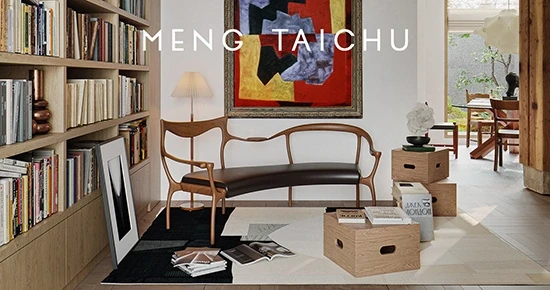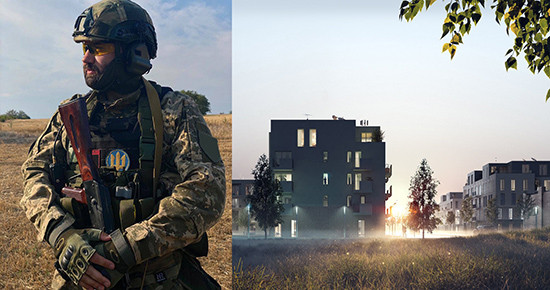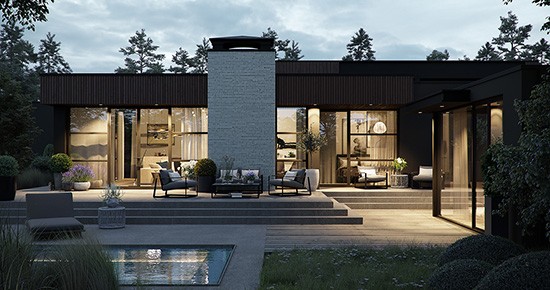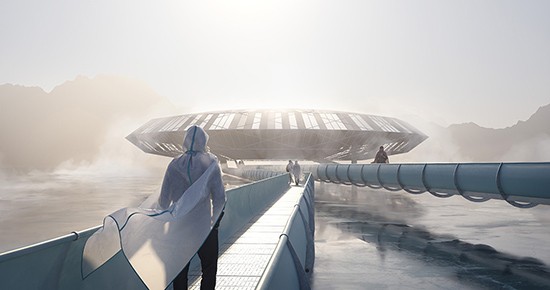Alexander Kuzmenko

1. Tell me about yourself. Why did you choose 3D graphics.
My name is Alexander, I am 24 years old. Originally from a small village near Kiev. I am an architect by education. I chose the direction of architectural visualization after working in the field of architecture and realized that designing cannot give me the freedom to create that I imagined during my studies. In this way, I chose architectural visualization, as it allowed me to create and unleash the potential that was in me more.
2. How was the training schedule.
My acquaintance with graphics and art happened during my college years. There I first met face to face with an academic drawing, an architectural composition and colorist. For me, it was a completely new unexplored world that I had just begun to learn. During my studies, my first acquaintance with 3D happened. At that time, I already started trying to learn Cinema4D, ArchiCAD and SketchUp myself. You can see my then attempts below (coursework in the 3rd course and thesis)


After completing my studies and getting a diploma, I decided to get a job in the specialty. But she could not satisfy my thirst for creativity. So I changed a couple of jobs, trying different things. Over my humble career, I had to do many things. Starting from design, ending with graphic design (branding, identity for companies, business cards, website development, etc.), video editing and visualization. Thus, the principles of aesthetics, color theory and composition were born in my head. Just by viewing and analyzing other works in different directions and techniques.
At that time, architectural visualization was more a hobby for me than a means of earning. And the training was pretty slow. I tried to make the most of the materials I could find on the Internet. From material settings to some principles of camera setup. I tried, tried and tried again. I, at that time, did not have the opportunity to buy any course on architectural visualization or ask a more experienced friend what to do and had to deal with issues on my own.
At a certain point in my life, I came across at work with the most that neither is burnout. I had to do literally copy-paste from project to project without any progression. After a year of such “work,” I quit and was depressed. And not the depression that they hide behind when they are in a bad mood, but the real one. I literally wanted to just lie down and not move, looking at the ceiling. And with any attempt to do something - I was enough for a maximum of half an hour. After which I closed the project without saving, and from the bitterness of my inability to do anything, I simply lay on a log. This went on for about 2 months. But one day I woke up, with the thought: "Enough of this from me, I will do what I like!"
I gathered all my will into a fist and returned to work. There was only one desire - to prove to myself that I can! The main thing is to go towards this goal. I will not say that this path was simple, but in the end 2 works came out, under the names Green Space (thanks to Ola Moskalets for the design) and Morning in New York. In which I tried to put all my knowledge and all the experience that I had. After publishing these works on 3ddd and Behance, I realized that what I am doing may be interesting to people, and this encouraged me not to stop. Then I began, like crazy, to absorb all the information that I could get to. For the sole purpose. Become an architectural visualizer. The next leap in my professional level was work in the office. She allowed me to get new tasks and approach them the way I wanted. The main thing is the result. In this way, I continue to work in the studio and improve myself for more than a year and a half.

3. Why did you choose a studio job rather than freelance?
I started, like most probably, with freelance. I was glad to any work for any money. But at a certain point, I began to notice that with this work I become a person who is absorbed in work all day and night, and there are only breaks for sorties to the grocery store. The feeling that you, like a hermit in a dark cave who does not communicate with anyone, did not leave me.
And in the end I said to myself - “We need to change something!”, And got a job in the office. That's how I discovered for myself what office work is.
Among the pluses, in decreasing order, I would say:
- collective
- normalized working day
- stable cash income
After weighing the pros and cons, I decided that working in the office is more optimal for me than at home.
4. How was your job search in the studio? What pay more attention when applying for a job? What do you advise to pay attention to when looking for a job?
The very first thing an employer looks at is a portfolio. Be at least three times a candidate of science in architecture or something else, but if you do not give out the level of visualization that the company has ... most likely they will refuse you. This does not always happen, but the probability of failure is quite high.
There are companies that are ready to take a 3D visualizer a level lower for further training, but this is more an exception than the rule. Most need a ready-made specialist who will immediately get down to work.
The second point, I would single out sociability and stress resistance. Team communication and dialogue between all participants in the workflow is like a clock mechanism. If at least one element starts to fail, all the others stop. Do not be afraid to ask. The more questions you ask, the less questions will come out later.
Well, and where without stress resistance. Fails and punctures always occur, because this is part of gaining personal experience. Another question is whether you will be ready to accept your puncture, and not allow it in the future. There are quite few positions in the labor market, purely visualization. Usually everyone needs a designer with visualization skills. Such a station wagon, and come up with a concept, visualize, approve with the customer, and make drawings in addition.
If you are a designer with visualization skills, then this is a plus now on the market. But do not be afraid that if you are a pure visualizer, then they won’t take you anywhere. One has only to stock up with patience and a good portfolio. On the market always, with some periodicity, the positions of the visualizer appear, and then it is better to be in full arms. Those who are prepared are always more lucky.

5. Do you freelance in your free time?
Very rarely. There are a couple of projects that I’m doing right now, but this is more of an opportunity to revive an interesting design than a financial issue. But still, when you take an additional freelance project to your main job, you need to be prepared that you will get tired 2-3 times faster, and there will always be not enough time to keep up with everything.
6. Tell us about your team of 3D visualizers. How many people work with you? are you friends?
Our team consists of 3D artists and also a visualizer (if we take into account only visualizers). We have a friendly team, we always try to prompt and help each other with advice or life hack. In terms of the division of work, we have worked out such a procedure that a designer is attached to each visualizer with a project, and he leads it to the very end.
So it’s going to keep the project flow in one style, and not set limits on the overall style of rendering visualization. Thus, each person has his own personal style, which can be traced throughout the project, and each grows with the progression in which it is convenient.
7. What projects do you like to do the most?
Most of all I like projects in which you are imbued with design and begin to work out it as you would for yourself. With the elaboration of small details, which at first glance seem insignificant, but in fact they allow you to revive this space and bring it to reality. From such projects I’m straight.

8. Where are you looking for inspiration for your work?
All around. Instagram, Behance, Pinterest, the work of other archivers, interesting pictures of photographers from the network, some forms or textures are just on the street. Everything goes into use. You simply accumulate these elements and images in yourself, and in the future they simply emerge from the subconscious and help you in your work.
9. Do you continue to improve your skills? Level up? How? Lessons, conferences.
Self-development is an important element, probably, of every profession. Without it, sooner or later there will come a time when you are fed up with the monotony of work.
I try to always approach this issue quite unconventionally. If there is a desire to try a new pipeline work, or a new tool, then I am implementing it in the current project. Thus, it is possible to study the instrument and test it in practice.
Also, I try to look at other types of 3D graphics and try my hand at them. Modeling, Motion, VR / AR, gamedev. All these areas intersect with those things that we usually do. Therefore, nothing interferes with the parallel architectural visualization, learn hard-surface modeling or procedural ticking, because you never know what you will need from this when solving a new problem.
10. What is a regular 3D architectural visualizer in Ukraine? Advantages and disadvantages.
Our market is developing quite rapidly. But it reminds me of the design market of the early 2000s, when no one had yet fully understood who designers are and what the difference is between them. But if you look now, then people already have an understanding that the designer does not just select wallpapers, but tiles in the epicenter. This is the person who thinks through your home in such a way that you yourself would be as comfortable as possible in it and would like, after a difficult working day, to return to it.
Now the visualization market is only gaining momentum. Many people think that this is just a tool to show, "And how this thing will be in life." But there are those who understand that architectural visualization is a powerful tool for promoting any product. After all, most of the things in our lives we know with our eyes, and understanding how to make your eyes Wow! - is worth a lot. I believe that in the near future there will be more and more vacancies of 3D visualizers, because more and more people understand how you present the product, so they perceive it.

11. Have you had any suggestions to leave to work abroad? If so, why stayed.
There were no such offers, but I thought about this. After many events that were in the country, you wonder whether to go somewhere, where everything is calm. But still, for myself, I found a lasting solution to this question.
Develop as a specialist! After all, we have such supportive soil. Our market is developing rapidly and we have a bunch of cool specialists in this field. The level of visualization has grown, and companies are already contacting us from the side to order from us. So why is it worth leaving somewhere when you can get all this from us. Yes, you have to work hard, but everywhere.
Develop yourself, market, country! It sounds a bit populist, but it is. The development of the entire industry and market depends on each of us.
12. How do you prefer to spend free time from work? Sport, travel. He asks a workaholic, a workaholic:
- How do you relax?
- I work.
- That is, you rest at work?
- No, I work at work.
I'm one of those. It’s hard for me to rest, because I’m constantly on the move. If there is a free minute - I try to spend it profitably. Learn something new, see, study, do, discuss. But, like everyone else, there are times when you just want to lie down and that no one would touch you, at least for a couple of days.
Just half a year ago I discovered podcasts for myself (if anyone isn’t in the know, podcasts are audio, made in the form of a program, with presenters, interesting topics and guests. You just listen to the dialogue of the presenters on an interesting topic while you are going to work or doing household chores ) and with their help, I learned a lot of things for my horizons. Did you know that during the presentation of his new work, Dali nearly died?
Once, in London, Dali presented his new work, Phone Lobster, and since he was a shocking person, he decided to make an unusual presentation. He came to her in a diving suit (in such a bulky, with a trellised helmet, as in old films), in one hand he held a pack of Russian greyhounds, in the other hand he had a billiard cue. And on the cover of his diving suit is the Mercedes logo. Imagine this picture? So, Dali began to present his work, but found that in this suit there is no air ventilation and he begins to suffocate. He tried to gasp for air, like a fish thrown onto ice, and everyone in the room began to laugh. "Oh look, Dali in his repertoire." But his friends noticed in time that he still does not imitate, but suffocates for real. They ran to him and started with hammers and all that came to hand to knock these screws off his helmet. They managed to free him.
The moral is - do not overdo the feed, and think through everything before you do it!
So, you can usefully spend time on the road or while there is a free minute. It's good that there are a lot of topics for podcasts, and everyone can find something interesting for themselves.

13. What are you striving for in your work. What peaks, results?
In fact, no matter how trite it sounds, to realism. Yes, now everyone can already produce a photorealistic picture, but in my work I try to adhere to the rule. Details are the same important elements of the environment as the color of the walls and the texture of the wood on the facades. They betray reality to the render and make it clear, on a subconscious level, who lives in this environment and what habits or preferences this person has.
14. Wishes, advices and parting words to the audience.
In our hard business, the main thing is to believe in yourself. Feeling that you like the business that you are doing and gives you strength to move on. Not afraid to try something new, experiment and self-develop. Indeed, in our hands a tool and the ability to create something beautiful with our own hands. And this, as for me, is worth a lot.
Now I will turn to you personally, to the one who reads these last lines.
You already know that your determination is enough to turn mountains, not to learn the development and ior materials for memory. Indeed, real art is not born in the head, but in the heart!
Thank you for reading this little spitch. I hope you found something useful for yourself in it. Good luck and inspiration to you in everything!
Instagram author profile: instagram.com/arch.kuzmenko/
Link to the author’s portfolio: behance.net/archkuzmenko

Jean-Paul El Hachem, JPAG Atelier
Meng Taichu
Alexander Suharukov. Founder Provisual.pro
Egor Shtefan
Experience in a 3D visualization studio in Budapest
Vitalii Tomak

Latest Discussions
Woowww it s look awsome
This is simply amazing. I am in love with this atmosphere.
Thank you so much!! 
Beautifully composed scene! The sense of depth and lighting are just perfect. ✨
Harika bir sahne kurgusu! Derinlik ve ışık kullanımı mükemmel. ✨















Woowww it s look awsome